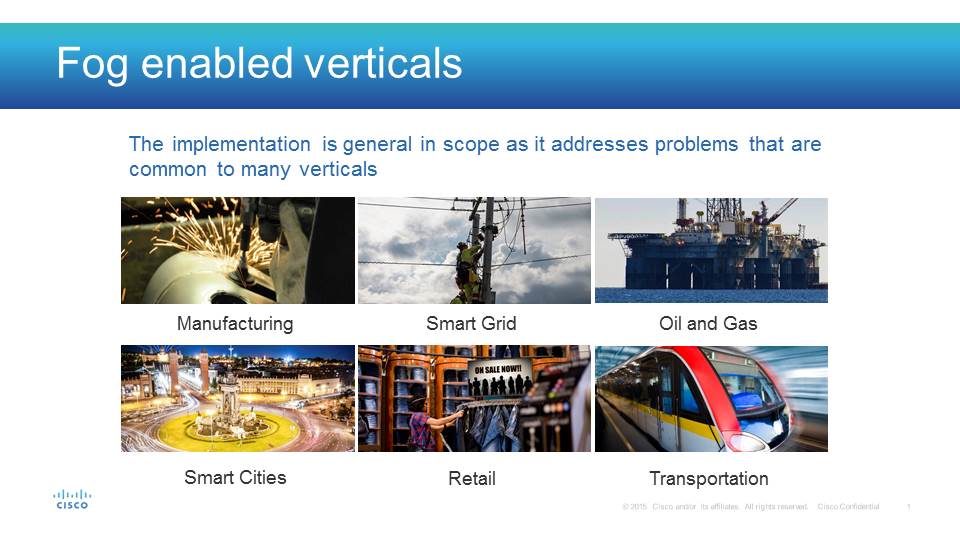I have the privilege of being in Barcelona this week for Mobile World Congress. With nearly 100,000 attendees and an impressive conference agenda, it’s a week packed with not only ideas and innovation, but with interactions with leaders, startups, disruptors, and other major players in mobile technology.
The topic of mobility continues to dominate and fuel our industry,, particularly because of the opportunities made possible by my other passion, fog computing. As mobile network traffic continues to explode, traditional cellular, backhaul and packet core architectures will begin to fall short. By deploying the computation, networking, and storage capabilities of fog at the edge of their networks, mobile service providers can substantially improve performance, security, capacity, and reliability—and create significant new revenue opportunities.
One exciting new opportunity for service providers is “Fog as a Service” (FaaS), where a service provider builds out an array of fog nodes across its geographic footprint, and acts as a landlord to many tenants from many vertical markets. Each fog node hosts local computation, networking, and storage capabilities. The nodes can be packaged for outdoor deployment, perhaps in street corner cabinets, on rooftops, or integrated in fiber nodes or cells. The fog software infrastructure might include virtualization, orchestration, sophisticated security, and the application programming interfaces needed to enable many different stakeholders to generate a wide variety of applications that run with a minimum of integration fuss.

Once the fog network is deployed, the FaaS provider would lease fog capabilities to many tenants, such as municipalities (managing government operations, sanitation, surveillance, or emergency services); transportation companies (dispatching taxis, logistics tracking of deliveries, fleet management); broadband service and content providers (operating co-located Wi-Fi or microcells, caching, customer relationship management, fault tolerance); or even nearby buildings (hosting energy management or security services), to name a few. If each of these tenants built out its own fog network, the total cost would be astronomical, and the city would be choked with functionally overlapping fog boxes.
Offering FaaS is analogous to being a cloud service provider, but enabling whole new classes of services on the fog network. The first service provider to build out large, closely spaced arrays of high performance, highly scalable fog nodes across a city or region will have a huge advantage—becoming the “Amazon Web Services of fog” for that region.
Fog computing is a critical, exciting opportunity to enable IoT in Smart Cities, and many other verticals, including smart transportation, smart grid / utilities, manufacturing, enterprise / retail, energy, healthcare, agriculture, residential / consumer, and hospitality. New use cases in each of these verticals are made possible by the specific advantages of fog computing, including low latency, controlled network bandwidth, improved security, scalability on multiple dimensions, and potential for high service availability. Trying to implement these use cases as exclusively cloud-based apps would result in unacceptably high costs, unacceptable performance, or flat-out failed systems.
For example, it’s not be feasible to pay wireless network charges to carry large numbers of high-bandwidth sensor data streams from remote locations—such as a deep-water oil rigs—all the way back to the cloud. But if local fog nodes perform data analytics on these streams, only summary results or exceptions need to be sent back to the cloud. Fog computing also provides the high performance required by time-sensitive applications such as haptics systems, in which force feedback is provided on a joystick for applications including telemedicine, training, and games. In these cases, if the round trip delay between the user interface and the computational resources is more than a few milliseconds, the illusion of touch is lost. And in smart highway applications, such as automated collision avoidance systems, those few milliseconds can mean the difference between life and death.
This week in Barcelona, many of the Mobile World Congress attendees may not even realize they are experiencing the benefits of fog computing as they move around the city. The City of Barcelona, together with Cisco and several partners, have implemented a proof of concept to demonstrate how fog computing can facilitate the delivery and management of urban services, such as smart lighting and power management, smart traffic management, and security. Not only does this initiative enable a host of city services, but its broad network of fog nodes also demonstrates some of the capabilities of FaaS, such as support of multiple tenants and virtualization at the edge
I believe fog computing is going to be a key enabler for future IoT service infrastructures—and Fog as a Service will be a key opportunity for service providers. Having a world-class fog network directly attached to a traditional mobile network opens up vast revenue opportunities. IDC projects that by 2018, 40 percent of data will be stored, processed, or analyzed near the edge. Fog is a multi-billion dollar opportunity for network service revenue, and a “network killer” if your fog deployment falls behind competing networks’ fog capabilities.
CONNECT WITH US